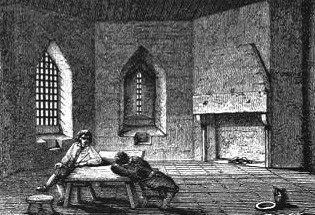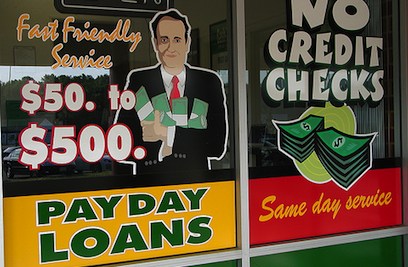A Brief History of America's Love Affair with Debt
David Schmidt, May 5 2012
 A British Debtors' Prison, c.1750
A British Debtors' Prison, c.1750In a way, America's love affair with debt started before the new world was even colonized. The British had an insatiable appetite for low interest loans, which gave rise to the enormous debtor’s prisons that still remain famous today. Many of the poor souls destined to spend their lives in these prisons were considered dishonest, fraudulent, and a bane on society. Some of them were hanged for their crimes, but the large majority languished, unable to work or repay their debts.
Loans and Debt in Colonial America
When British colonists arrived in the new world they continued the tradition of acquiring debt and harshly punishing those who could not repay. One example will suffice: the Pennsylvania Bankruptcy Act of 1785 allowed authorities to flog debtors and even cut off the ear in some cases. Yet, Americans continued to borrow.
Financing the War of Independence with Debt
Soon, debt took an altogether different meaning for colonists and the founding fathers. Rather than a reprehensible act, it became a necessary evil in order to defeat the vile British army. After the colonists had won, many of the president’s advisors balked at the hefty bill that was accumulated. The newly freed America owed approximately $12 million to France and at least $25 million to citizens who sold food, horses, and other supplies to the colonial militia. In effect, the country was born in a sea of debt.
Even those who opposed debt the most were guilty of the same transgressions as many common Americans. Thomas Jefferson -- arguably one of the early conservative states' rights politicians -- bought fine wines and other luxury goods on credit alone. He accumulated hundreds of thousands of dollars of debt (the equivalent of millions today) and died with a heavy debt burden upon him. In fact, after his death lenders were re-paid when his estate and property were all auctioned off.
American Loans in Modern Times
In the twentieth century the temperament towards debt tapered off rapidly. Floggings were outlawed and debtors were still hassled, beaten, and even killed, but usually at the hands of thugs rather than police. People started to borrow more, but it wasn’t until the late 20th century when the debt explosion really occurred.
Modern Culprits of Debt Problems
Credit card debt, student loans, and the advent of payday loans all brought the downfall of creditors in a never ending cycle of pain. Private debt in America, while less discussed in political arenas, is just as worrisome.
Payday loans are controversial, yet widely used across the United States. Americans hold upwards of $40 billion in payday loan debt and many are used by poor and lower class citizens to get by. A large percentage of these debtors use payday loans to make ends meet. A common characteristic of many debtors is using a payday loan from one company in order to pay another. Although these are smaller loans, the payday lenders hassle users far more brazenly than other industries.

Small business loans are another large source of private debt in the United States. While less hazardous than payday loans, there is a total of $68 billion owed to banks and other lenders by the small business community. Many of these debts go unpaid as companies collapse, but that is the cost of doing business.
Student loan debt is a painful reminder of America’s love affair with loans and credit. In total, there is $556 billion in outstanding student loan debt. Many Americans are paying these debts for the majority of their lives.
No list of American debt would be complete without a mention of the enormous amount of credit card debt that citizens hold. In total, the Federal Reserve Board of Governors has estimated that Americans owe approximately $953.1 billion.
Perhaps the latest rise in American private debt is caused by a change in attitude within the past few decades. Declaring bankruptcy and “getting away scot free” is a completely different attitude than British authorities or debtors once had. The first years of the Union until modern times has displayed a different attitude, but Americans today seem more in love with loans and debt than ever. It is doubtful that America will ever divorce its faithful lover, but perhaps China will, at some point, realize they need to open a debtor’s prison of their own.
